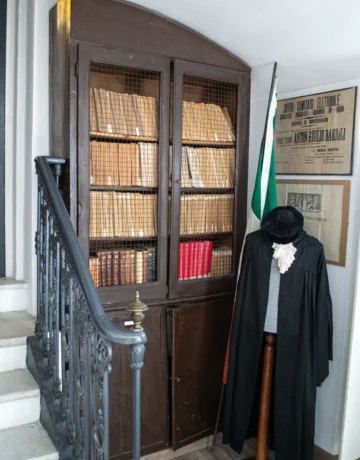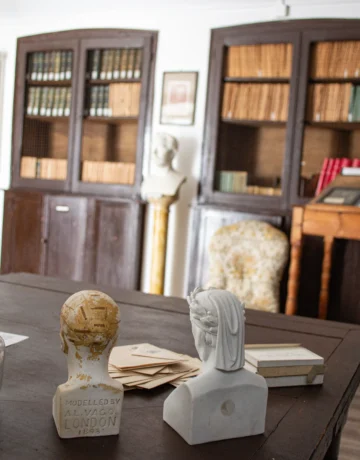Relics
 The room is equipped with furniture evoking the style of the previous room, in which we can find various Italian and foreign newspapers, belonged to Barrili and subsequently bound exposed. You can also find old prints, drawings, photographs, poems, some lectures that Anton Giulio Barrili held at the University of Genoa and musical scores by his mother Mrs. Maura Pertica.
The room is equipped with furniture evoking the style of the previous room, in which we can find various Italian and foreign newspapers, belonged to Barrili and subsequently bound exposed. You can also find old prints, drawings, photographs, poems, some lectures that Anton Giulio Barrili held at the University of Genoa and musical scores by his mother Mrs. Maura Pertica.
The boxes host red folders containing the correspondence of Barrili, including letters written by Giuseppe Garibaldi, Giosuè Carducci, Giovanni Pascoli and many other illustrious friends. There are also the ones written by Mr Buitoni (the owner of the Buitoni Italian Pasta Company) who, in addition to asking Barrili for advice, often sent him some new types of pasta to taste.
There are also many letters sent by admirers of Barrili who wanted to know him, asked for advice and, sometimes, financial help. He was in fact a man of honour and endowed with great generosity. It is said that, thanks to his donation of 30,000₤ (old Italian liras), a very high amount for the time, the parishioners of Carcare had a new church, more suited to the needs of the community: during a dinner, hearing the complaints of the parson due to the lack of funds for the church, Barrili, probably already slightly tipsy, offered to contribute so much money that he was not believed. But the next day he went to the parish priest in person and signed the check with the promised sum.
 You can admire a copy of a painting depicts the writer in Garibaldi’s uniform hangs on the doorframe because of the original of which belongs to the heirs.
You can admire a copy of a painting depicts the writer in Garibaldi’s uniform hangs on the doorframe because of the original of which belongs to the heirs.
Some of the most interesting relics of our Museum are exposed in the showcase in the centre of the room:
- the sword and cap of the Garibaldian uniform;
- the mitt used to fight and that was probably used to protect his arm that had been injured during a duel. This is because the newspaper “Il Movimento“, of which Barrili was director, was a spokesman for Garibaldi’s ideals. This often led the writer to stand up openly and to have to defend their ideas even by duelling directly with those who did not share them. In one of these circumstances he was wounded in the arm by an officer and was forced, in subsequent duels, to repair the injured limb with the glove here shown;
- the Masonic collar dating back to his affiliation to Freemasonry, probably at the invitation of Garibaldi;
- the ermine stole, a characteristic garment of the University Rectors, worn by Barrili during the ceremonies at the University of Genoa;
- his Hunter of the Alps (Cacciatore delle Alpi) hat;
- a patriotic flag from 1847. The date of the flag’s display was to be 2 November 1847, but since it was not possible to exhibit it on that date, because of public order problems, the event was moved to 10 November when the Italian Hymn was first performed in Genoa;
- his regular firearms license of our writer, some packs of ammunition and the gunpowder holder.
Previously there were also some duelling pistols, which unfortunately have been stolen.
